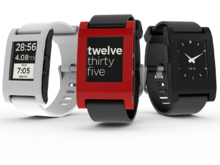
Pebble (watch)
Discontinued smartwatch / From Wikipedia, the free encyclopedia
Dear Wikiwand AI, let's keep it short by simply answering these key questions:
Can you list the top facts and stats about Pebble (watch)?
Summarize this article for a 10 year old
Pebble is a discontinued smartwatch developed by Pebble Technology Corporation. Funding was conducted through a Kickstarter campaign running from April 11, 2012, to May 18, 2012, which raised $10.3 million; it was the most funded project in Kickstarter history, at the time. Pebble began shipping watches to Kickstarter backers in January 2013.[17] Pebble watches can be connected to Android and iOS devices to show notifications and messages. An online app store distributed Pebble-compatible apps from many developers including ESPN, Uber, Runkeeper, and GoPro.
 | |
 | |
| Also known as | Pebble |
|---|---|
| Developer | Pebble Technology, Corp., Pebble Devices, Corp in California.[1] |
| Manufacturer | Foxlink Group in Taiwan[2] |
| Product family | Pebble |
| Type | Smartwatch |
| Generation | 1 |
| Release date | January 23, 2013 (2013-01-23) |
| Introductory price |
|
| Discontinued | December 7, 2016 |
| Units sold | 2,000,000+ as of December 2017[update][4] |
| Operating system | Pebble OS; uses a customized FreeRTOS kernel.[5][6] Can communicate with Android and iOS apps using Bluetooth. Portions of Pebble OS are closed source.[7] |
| CPU | STM32F205RE Cortex M3 CPU |
| Memory | RAM 128 KB (84 KB OS, 24 KB app, 12 KB background worker, 8 KB app services)[8] |
| Storage | Pebble Time series: 50 slots for faces/apps stored on watch, infinite can be loaded from the connected phone. Pebble Classic series: 8 slots for apps/watch faces, 100 KB per slot for a total of 800 KB user accessible space. The Kickstarter version has 4 MiB (32 Mibit) flash.[9][10] Originals built after October 2013 and all Steel watches have 8 MiB (64 Mibit) flash.[11][12][13] All models also have 512 KiB SoC flash memory |
| Display | 32-millimetre (1.26 in) 144×168 pixel Sharp Memory transflective LCD[14][15] |
| Graphics | Pebble Classic/Steel: 1-bit black-and-white transflective LCD; Pebble Time: 64 (6-bit) color e-paper. |
| Sound | None |
| Input | 4 buttons 3-axis accelerometer with gesture detection magnetometer and ambient light sensor,[5] microphone on Pebble Time models |
| Camera | None |
| Connectivity | Bluetooth 2.1 and 4.0 LE (used for iOS 7 notifications) + EDR |
| Power | 130 mAh, 7 days (assuming c. 20–30 notifications a day, and a per-minute updating watchface) |
| Current firmware | Version 4.3 |
| Dimensions | Pebble: 52 mm × 36 mm × 11.5 mm (2.05 in × 1.42 in × 0.45 in),[16] Pebble Steel: 46 mm × 34 mm × 10.5 mm (1.81 in × 1.34 in × 0.41 in) |
| Mass | Pebble: 38 g (1.34 oz), Pebble Steel: 56 g (1.97 oz) (with default watchband attached) |
| Successor | Pebble Time (both normal and Steel variants) |
| Related | Fitbit |
| Website | pebble.com |
A steel-bodied variant to the original Pebble, the Pebble Steel, was announced at CES 2014 and released in February 2014. It had a thinner body, tactile metal buttons, and a Corning Gorilla Glass screen. It was available in two finishes: black matte and brushed stainless steel, with both a black leather and a matching steel band.
In 2015, Pebble launched its second generation of smartwatches: the Pebble Time and Time Steel. The devices were similarly funded through Kickstarter, raising $20.3 million from over 75,000 backers and breaking records for the site. In 2016, Pebble shut down their subsequent Time 2 series watches and refunded Kickstarter backers, citing financial issues.[4]
On December 7, 2016, Pebble officially announced that the company would be shut down, and would no longer manufacture or continue support for any devices, nor honor any existing warranties.[4] Pebble's intellectual property was purchased by Fitbit, a wearable technology company specializing in fitness tracking, who also hired some of the Pebble staff. Further clarification on the transition timeline and efforts to render Pebble OS and its watchfaces/apps more self-sufficient was posted to the Pebble Dev Blog on December 14, 2016.[18] Support for the Pebble app store, online forum, cloud development tool, voice recognition, and voice replies ceased in June 2018,[19] although support for some online services was restored by the unofficial "Rebble" community.